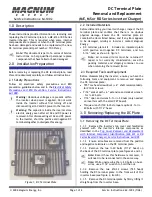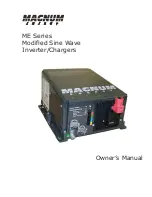
TECHNICAL INFORMATION
2001 Xantrex Technology, Inc.
5916 - 195th Street N. E.
Arlington, WA 98223
Telephone: 360/435-8826
Fax: 360/435-2229
www.traceengineering.com
SW Series Inverter/Charger
Part No. 2031-5
Rev. C: February 2001
Page
99
TECHNICAL INFORMATION
BATTERY TYPE
This section of the manual is included to help you better understand the factors involved with battery
charging, care, and maintenance, by discussing the physical make-up and characteristics of chemical
storage batteries. This is not intended to be an exhaustive discussion of battery types, but simply a
guideline. The manufacturer of each specific battery is the best authority as to its use and care.
Batteries come in different sizes, types, amp hours, voltages and chemistries. There are nearly as many
descriptions of exactly how batteries should be charged, as there are people willing to offer explanations.
It is not possible here to discuss all aspects in detail. However, there are basic guidelines you can follow
that will help in battery selection and ensure that the batteries are better maintained than the majority.
See the INVERTER/CHARGER TERMINOLOGY on page 115 for a brief description of terms that appear
in this section with which you may not be familiar.
SELECTION OF BATTERY TYPE
There are two principal types of batteries: starting and deep-cycle. There are several different types of
battery chemistries including liquid lead-acid, nickel-iron (NiFe), nickel-cadmium (NiCad), alkaline, and
gel-cell. Batteries are either sealed or vented.
STARTING BATTERY
These are designed for high cranking power, but not deep cycling. Don’t use them. It does not hurt the
inverter - they simply will not last long in a deep cycle application. The way they are rated should give a
good indication of their intended use. "Cold Cranking Amps", is a measure of the amperage output that
can be sustained for 30 seconds. Starting batteries use lots of thin plates to maximize the surface area of
the battery. This allows very high starting current but lets the plates warp when the battery is cycled.
TELEPHONE COMPANY BATTERY
Second-hand telephone company batteries are often available at far below original cost. They are often
used to power the telephone system for short power outages. They are sometimes used successfully in
remote home systems. Typically, they are a lead calcium type battery, similar in construction to a starting
battery. Therefore, they should not be repeatedly discharged more than 20% of their amp/hr rating. Keep
this in mind when evaluating their amp/hr to cost ratio.
DEEP CYCLE BATTERY
This is the type of battery best suited for use with inverters. The physical dimension of the plates are
thicker and the active material that holds the charge is more dense to increase cycle life. The “deep cycle”
type of battery is designed to have the majority of their capacity used before being recharged. They are
available in many sizes and in either “non-sealed” or “sealed” types.
NON-SEALED LEAD ACID BATTERY
The most common type of deep cycle battery is the non-sealed, liquid electrolyte battery. Non-sealed
types have battery caps. The caps should be removed periodically to check the level of electrolyte.
When a cell is low, distilled water should be added. The electrolyte level should be checked monthly
and topped up if needed after recharging.
The most common “non-sealed” deep cycle battery is the type used with boats and motor homes.
They typically are called “Group 27” batteries and are similar in size to a large truck battery. They are
12-volt batteries rated at 80 to 100 amp-hours. Often the deep cycle claim is over-stated. They do
work better than a car battery, but are not recommended for anything but the smallest systems.
Another popular and inexpensive battery of this type is the "golf cart" battery. It is a 6-volt battery rated
at 220 amp-hours. They can be cycled repeated to 80% of their capacity without being damaged. This
is the minimum quality of battery that should be used with SW Series inverter applications.
Many systems use the L16 type of battery. These are 6-volt batteries rated at 350 amp-hours and are
available from a number of manufacturers. They are 17 inches in height and weigh up to 130 pounds
each - which may be troublesome in some applications such as RV or marine installations.
Summary of Contents for SW Series
Page 151: ......
















































